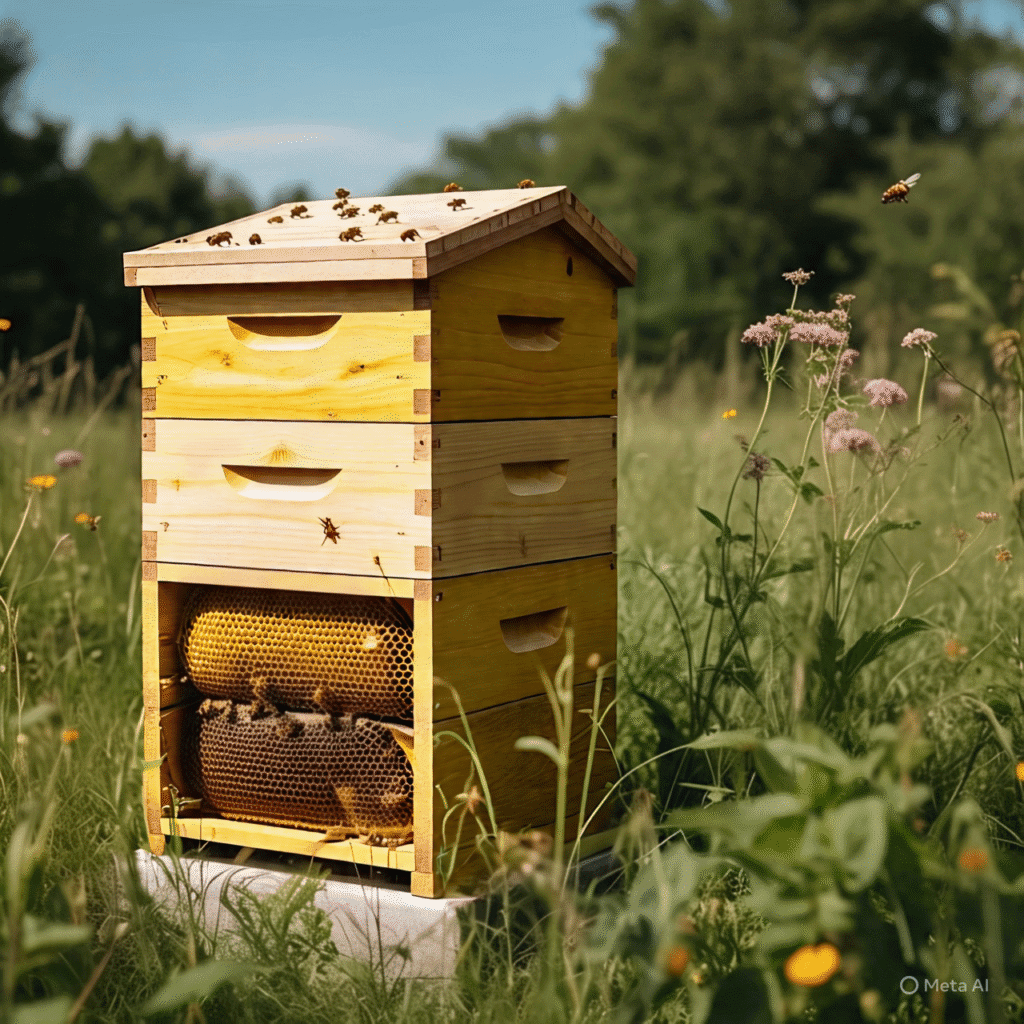Explore the key differences between Flow Hives and Traditional Hives in this ultimate guide. Learn the pros, cons, costs, honey yield, and which hive type best suits modern and beginner beekeepers.
Beekeeping has seen remarkable innovations over the years, but none quite as revolutionary in recent times as the Flow Hive. It promises a simpler, less disruptive way to harvest honey compared to the long-established Traditional Hive systems such as the Langstroth hive. Whether you’re a novice beekeeper or an experienced apiarist, understanding the differences, benefits, challenges, and practical implications of each system is crucial for making an informed decision.
What is a Traditional Hive?
A Traditional Hive refers most commonly to the Langstroth hive, invented in 1851 by Lorenzo Langstroth. It is the gold standard in modern beekeeping and consists of:
- Stackable boxes (supers): Each containing removable frames where bees build natural or foundation-supported comb.
- Removable frames: Allow beekeepers to inspect bees, brood, and honey stores without destroying the hive structure.
- Standardized dimensions: Facilitate scalability and compatibility with equipment worldwide.

How Honey is Harvested in Traditional Hives
- Frame removal: Beekeepers open the hive and carefully remove honey frames.
- Uncapping: Beeswax cappings are removed manually or by machine.
- Extraction: Honey is spun out using a centrifugal extractor.
- Filtering and bottling: Honey is filtered and stored.
Advantages of Traditional Hives
- Proven reliability: Over 150 years of use and improvements.
- Flexibility: Compatible with various beekeeping methods including migratory beekeeping, queen rearing, and pest management.
- Cost efficiency: Lower initial costs and widespread availability of equipment.
- Thorough inspection: Allows detailed hive health monitoring (disease, pests, queen status).
Challenges of Traditional Hives
- Labor intensive: Honey extraction is time-consuming and messy.
- Bee disturbance: Opening hives and frame removal disturbs the colony, risking stress and aggression.
- Specialized equipment: Requires uncapping tools and extractors.
- Messy honey harvest: Requires space and time for processing.
What is a Flow Hive?
The Flow Hive is a patented beekeeping innovation introduced in 2015 by Australian inventors Cedar and Stuart Anderson. It modifies the traditional Langstroth frame with a clever mechanism that lets honey be harvested without removing frames or disturbing bees as much.

How the Flow Hive Works
- Flow Frames: Plastic frames contain partially-formed hexagonal cells with a special split design.
- Lever Mechanism: Turning a lever causes the cells to shift, splitting the honeycomb vertically inside the frame.
- Honey Flow: The splitting action opens channels for honey to flow down into a sealed gutter at the bottom.
- Collection: Honey drains directly into a jar or container outside the hive, without opening the boxes or removing frames.
Advantages of Flow Hives
- Minimal hive disturbance: Reduces stress on bees during harvest.
- No uncapping or extraction: Eliminates the need for uncapping knives or centrifugal extractors.
- Cleaner process: Honey is collected directly, reducing mess and time.
- Encourages beekeeping: Lowers barriers for beginners and hobbyists.
Challenges and Considerations
- High upfront cost: Flow Frames and hives are significantly more expensive than traditional equipment.
- Limited inspection: The frames are sealed and integrated, limiting the beekeeper’s ability to perform detailed brood or pest inspections without dismantling.
- Honey quality: Some critics suggest honey collected may contain more moisture or bee secretions since it is not processed as thoroughly.
- Plastic components: Some purists prefer natural beeswax comb over plastic foundation or frames.
Side-by-Side Comparison: Flow Hive vs Traditional Hive
| Aspect | Flow Hive | Traditional Hive |
|---|---|---|
| Honey Harvesting | Honey flows out via lever-operated Flow Frames | Frames removed, uncapped, and centrifugally extracted |
| Initial Cost | Higher; specialized Flow Frames and components | Lower; widely available, standard Langstroth frames |
| Bee Disturbance | Minimal during harvest, less hive opening | Moderate to high; hive opened, frames removed |
| Ease of Use | Easier for beginners; less physical labor | Requires skills in hive management and extraction |
| Inspection | Limited; frames are harder to inspect individually | Easy; frames removable for thorough inspection |
| Maintenance | Requires monitoring for jams in Flow Frames; cleaning flow channels | Regular hive management including wax replacement |
| Honey Quality | Raw, less processed; sometimes more moisture content | Often filtered and processed, lower moisture |
| Scalability | Suitable mostly for hobbyist to small-scale setups | Used in hobbyist and commercial beekeeping |
Detailed Benefits of Flow Hives
- User-friendly harvesting: The Flow Hive makes honey collection as easy as turning a tap, allowing novice beekeepers to harvest honey without extensive equipment or expertise.
- Reduced bee stress: Opening traditional hives disturbs bees, increasing defensiveness and colony stress. The Flow Hive’s minimal intervention approach is kinder to the bees.
- Cleaner operation: No uncapping knives or honey extractors needed. This reduces sticky mess and equipment cleanup.
- Increased beekeeper engagement: The novelty and ease of use encourage urban and casual beekeepers to maintain healthy hives.
Detailed Benefits of Traditional Hives
- Comprehensive hive management: The ability to remove and inspect individual frames helps detect diseases, mites, and queen health issues early.
- Flexibility in hive design: Langstroth hives can be expanded vertically or horizontally, adapted for various climates and beekeeper needs.
- Lower upfront investment: Beekeepers can start with fewer frames and upgrade gradually.
- Better honey control: The extraction process removes excess moisture and impurities, producing higher quality honey with longer shelf life.
Potential Drawbacks to Consider
Flow Hive Drawbacks
- Cost: The system is pricey; frames can cost multiple times more than traditional ones.
- Limited inspection: Since Flow Frames are sealed, beekeepers can’t inspect brood patterns easily, which might affect early detection of pests and diseases.
- Maintenance complexity: The moving parts need cleaning and can jam, requiring more technical care.
- Plastic use: Some beekeepers prefer wooden frames with natural beeswax foundations for healthier comb building.
Traditional Hive Drawbacks
- Labor intensive: The honey extraction process is messy and requires equipment like extractors and uncapping tools.
- More bee disturbance: Opening the hive can agitate the colony, potentially impacting bee health and productivity.
- Time commitment: Processing honey takes hours and space.
- Requires skill: Beekeepers need to learn more complex hive management techniques.
Which Hive Should You Choose?
Choose a Flow Hive if:
- You want a low-effort, beginner-friendly honey harvesting experience.
- You prefer minimal disturbance to bees.
- You have a higher budget for beekeeping equipment.
- You want a cleaner, mess-free honey collection process.
- You are keeping a few hives as a hobby or in an urban setting.
Pros and Cons of Flow Hives
Pros:
- Honey harvesting is quick and easy
- Less invasive for the bees
- Cleaner honey extraction
- Great for urban or backyard beekeeping
Cons:
- Expensive upfront cost
- Plastic components may degrade over time
- Limited insights into hive health (brood inspection still needed)
- Not ideal for colder climates without modifications
Pros and Cons of Traditional Hives
Pros:
- Cost-effective
- Time-tested and widely supported
- More natural bee behavior
- Customizable and modular
Cons:
- Labor-intensive honey extraction
- Greater bee disturbance during harvest
- Requires more tools and experience
- Heavy lifting and potential for stings
Honey Yield Comparison
- Flow Hive: Yields can range from 2 to 7 kg (4.4 to 15.4 lbs) per frame depending on the nectar flow and colony strength.
- Traditional Hive (Langstroth): Yields vary but often exceed 20–60 lbs per harvest with full boxes.
Note: Honey yield depends more on colony health, climate, and forage availability than hive type.
Which Hive Should You Choose?
Choose a Flow Hive if:
- You want minimal contact with bees
- You live in an urban or suburban setting
- You’re a beginner seeking convenience
- You’re able to invest more upfront
Choose a Traditional Hive if:
- You want to learn hands-on beekeeping skills
- You aim for higher honey yield or commercial production
- You value sustainability and customizability
- You’re interested in natural hive behavior and breeding
Real Beekeeper Experiences
- Flow Hive Users: Many love the ease of use but often still open the hive regularly for inspections.
- Traditional Hive Beekeepers: Prefer control over hive management and enjoy more interaction with bee biology.
Some beekeepers even combine both, using Flow frames in a Langstroth body for hybrid benefits.
Environmental Considerations
| Sustainability Factor | Flow Hive | Traditional Hive |
|---|---|---|
| Materials | Wood + plastic | Primarily wood |
| Energy use | Low | Moderate (if using extractors, smokers) |
| Long-term repairability | Harder due to specialized components | Easy to replace individual parts |
| Impact on bee welfare | Good if brood is properly managed | Excellent with proper management |
Conclusion
Both Flow Hives and Traditional Hives offer unique benefits and challenges. Flow Hives bring innovation and convenience, perfect for hobbyists and those prioritizing minimal interference. Traditional hives, however, remain the foundation of commercial and sustainable beekeeping, offering full control and higher yields.
Whether you’re a backyard beginner or an aspiring apiarist, your choice should align with your goals, budget, climate, and level of involvement. In the end, the best hive is the one you’ll manage responsibly and enjoy working with—because successful beekeeping is about commitment, not just convenience.
FAQs
1. Is the Flow Hive suitable for beginners?
Yes, especially for those looking for easier honey harvesting, but brood management still needs learning.
2. Can I use Flow frames in a traditional Langstroth hive?
Yes, Flow frames are designed to fit standard Langstroth supers.
3. Do bees accept the plastic Flow frames?
Generally, yes. Bees finish building the comb and fill it with honey, although some colonies may take time to adapt.
4. How often should I harvest from a Flow Hive?
Only when the frames are full. Overharvesting can stress the colony.
5. Do Flow Hives eliminate the need for inspections?
No. You still need to open the hive to monitor brood health, queen activity, and disease.
6. Are traditional hives better for natural beekeeping?
Yes. They allow for more natural comb building and bee behavior.
7. Is honey from Flow Hives raw and organic?
It can be, if you don’t heat it and use organic beekeeping practices.
8. How long do Flow frames last?
With proper care, they can last several seasons, but they may degrade with UV exposure and use.
9. Which hive is better for cold climates?
Traditional hives are easier to insulate and modify for extreme weather.
10. Can I switch from Flow Hive to traditional later?
Yes. Beekeeping practices and equipment are adaptable with some adjustments.
I’m not sure exactly why but this web site is loading extremely slow for me. Is anyone else having this problem or is it a issue on my end? I’ll check back later and see if the problem still exists.
i have resolved that issue .You can now check it on your end